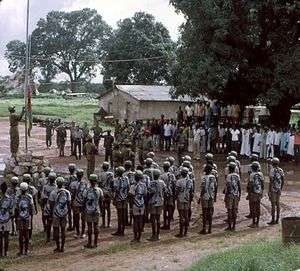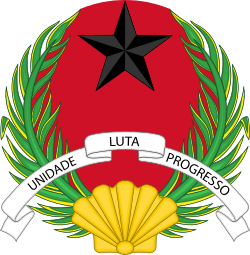Military of Guinea-Bissau
The Revolutionary Armed Forces of the People (Portuguese: Forças Armadas Revolucionárias do Povo) or FARP are the national military of Guinea-Bissau. They consist of an Army, Navy, Air Force and paramilitary forces. A 2008 United Nations Development Programme census estimated that there were around 4,000 personnel in the Armed Forces.[1] An earlier CIA World Fact Book figure was 9,250. The World Fact Book also estimated military expenditure as $9.46 million, and military spending as a percentage of GDP as 3.1%.
| Revolutionary Armed Forces of the People | |
|---|---|
| Forças Armadas Revolucionárias do Povo | |
 Flag of the Armed Forces | |
| Founded | 1964 (as the military branch of PAIGC) 1973 (as the national armed forces of Guinea-Bissau) |
| Service branches | Army Navy Air Force |
| Headquarters | Bissau |
| Leadership | |
| President | Umaro Sissoco Embaló |
| Defense Minister | Adiato Djaló Nandigna |
| Chief of General Staff | General Biague Na Ntan |
| Manpower | |
| Conscription | Selective compulsory military service |
| Active personnel | 4,000 |
| Expenditures | |
| Budget | $9.46 million |
| Percent of GDP | 3.1% |
| Industry | |
| Foreign suppliers | |
| Related articles | |
| History | Guinea-Bissau War of Independence Guinea-Bissau Civil War 2010 Guinea-Bissau military unrest 2012 Guinea Bissau coup d'état |
| Ranks | Military ranks of Guinea-Bissau |

The World Fact Book also reports that the military service age and obligation is 18–25 years of age for selective compulsory military service; 16 years of age or younger with parental consent, for voluntary service (2009).
Internal culture
2010 Guinea-Bissau military unrest
Major General Batista Tagme Na Waie was chief of staff of the Guinea-Bissau armed forces until his assassination in 2009.
Military unrest occurred in Guinea-Bissau on 1 April 2010. Prime Minister Carlos Gomes Junior was placed under house arrest by soldiers, who also detained Army Chief of Staff Zamora Induta. Supporters of Gomes and his party, PAIGC, reacted to the move by demonstrating in the capital, Bissau; Antonio Indjai, the Deputy Chief of Staff, then warned that he would have Gomes killed if the protests continued.[2]
The EU ended its mission to reform the country's security forces, EU SSR Guinea-Bissau, on 4 August 2010, a risk that may further embolden powerful generals and drug traffickers in the army and elsewhere. The EU mission's spokesman in Guinea-Bissau said the EU had to suspend its programme when the mastermind of the mutiny, General Antonio Indjai, became army chief of staff. "The EU mission thinks this is a breach in the constitutional order. We can't work with him".[3]
International drug trade
The multitude of small offshore islands and a military able to sidestep government with impunity has made it a favourite trans-shipment point for drugs to Europe. Aircraft drop payloads on or near the islands, and speedboats pick up bales to go direct to Europe or onshore.[4] UN chief Ban Ki-moon has called for sanctions against those involved in Guinea-Bissau's drugs trade.[5]
Air Force head Ibraima Papa Camara and former navy chief Jose Americo Bubo Na Tchuto have been named "drug kingpins".[6]
Angolan assistance
Angola, at the presidency of the Community of Portuguese Language Countries (CPLP) since 2010, has since 2011 participated in a military mission in Guinea-Bissau (MISSANG) to assist in the reform of defence and security.[7] MISSANG had a strength of 249 Angolan men (both soldiers and police officers), following an agreement signed between the defence ministers of both countries, as a complement to a Governmental accord ratified by both parliaments.[8]
The Angolan assistance mission included a programme of technical and military cooperation focused on a reform of the Guinean armed forces and police, including the repair of barracks and police stations, organisation of administrative services and technical and military training locally and in Angolan institutions. The mission was halted by the Angolan Government, following a politico-military crisis that led to the ousting of the interim president of Guinea- Bissau, Raimundo Pereira, and the prime minister, Gomes Júnior. By 22 June 2012, the Angolan vessel Rio M'bridge, carrying the mission's equipment, had arrived back in Luanda.
Army equipment
| Name | Origin | In service | Photo | Notes | ||
|---|---|---|---|---|---|---|
| Main Battle Tanks | ||||||
| T-34 | 10 | |||||
| T-54/55 | 10 | |||||
| PT-76B | 10 | |||||
| BRDM-2 | 10 | |||||
| YW531 | ||||||
| BTR-40 | 25 | |||||
| BTR-152 | 20 | |||||
| BTR-60PB | 35 | |||||
| AT-3 Sagger | 10 | |||||
| RPG-7V | ||||||
| B-10 recoilless rifle 82mm | ||||||
| BM-21 Grad 122mm 122mm | 9 | |||||
| D-30 122 mm howitzer 2A18 | 26 | |||||
| SA-7B | ||||||
| ZU-23-2 | 16 | |||||
| ZSU-23-4 Shilka | 16 | |||||
| 57 mm AZP S-60 | 10 | |||||
| AK-47 | ||||||
| AKM | ||||||
| RPD | ||||||
| RPK | ||||||
| FN-FAL | ||||||
| VZ-52 | ||||||
Air Force
After achieving independence from Portugal, the air force was formed by officers returning from training in Cuba and the USSR. The FAGB was re-equipped by the Soviet Union with a limited aid package in which its first combat aircraft were introduced.
Navy
In September 2010, Rear-Admiral Jose Americo Bubo Na Tchuto attempted a coup, but was arrested after failing to gain support. "Guinea-Bissau's navy chief, who was arrested last week and accused of trying to stage a coup, has escaped custody and fled to nearby Gambia, the armed forces said on Tuesday."[9]
References
- https://www.un.org/peace/peacebuilding/Country-Specific%20Configurations/Guinea-Bissau/Background%20Paper%20on%20SSR%2018.06.2008.pdf
- Assimo Balde, "Soldiers put Guinea-Bissau PM under house arrest", Associated Press, 1 April 2010.
- EU pull-out hits Guinea-Bissau reforms BBC
- Africa - new front in drugs war BBC
- BBC, G Bissau drugs sanctions threat
- British Broadcasting Corporation, US names two Guinea-Bissau military men 'drug kingpins'
- MENAFN, MISSANG Trains Police Staff in Guinea-Bissau, July 25, 2011
- "Military equipment used in Guinea-Bissau in Luanda". ANGOP. Retrieved 2017-07-12.
- http://www.alertnet.org/thenews/newsdesk... https://www.reuters.com/article/homepageC, http://news.bbc.co.uk/1/hi/technology/default.stm, retrieved on 12 August 2008, via afdevinfo, 16 September 2010
- The Two Faces of War
- World Aircraft Information Files. Brightstar Publishing, London. File 338 Sheet 02
- Cooper, Tom & Weinert, Peter (2010). African MiGs: Volume I: Angola to Ivory Coast. Harpia Publishing LLC. ISBN 978-0-9825539-5-4.
Further reading
- B Embaló, Civil–military relations and political order in Guinea-Bissau, The Journal of Modern African Studies, 2012
- Shaw, Mark, Drug trafficking in Guinea-Bissau, 1998-2014: the evolution of an elite protection network, The Journal of Modern African Studies, Vol. 53.3 (Sep 2015): 339-364.
External links
- http://africansecuritysector.blogspot.com/2010/09/guinee-bissau-restructuration-de-larmee.html, September 2010
- United Nations, Report of the Secretary-General on UNIOGBIS, S/2010/550, 25 October 2010. UNIOGBIS is the former United Nations Peacebuilding Support Office in Guinea-Bissau (UNOGBIS) and is closely involved in reform of the armed forces.
- http://www.slateafrique.com/85917/secrets-de-la-crise-bissau-guineenne
